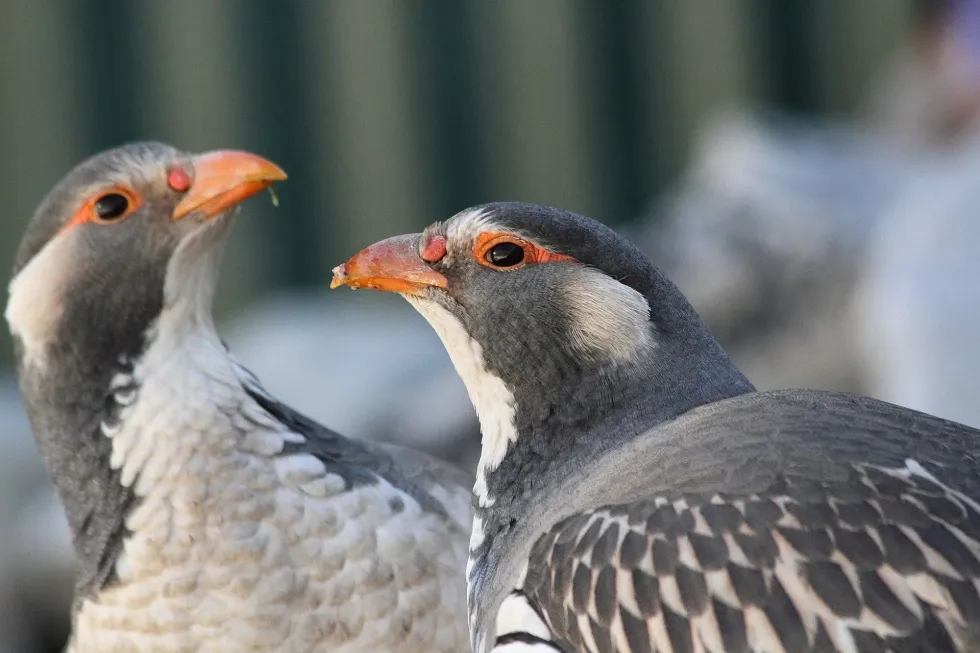Snowcocks are fascinating birds that mainly occupy cold regions and mountain areas. Tibetan snowcocks are a group of birds in the pheasant family, Phasianidae, of the Galliformes order. The distribution range of this bird species is widespread.
They are found in regions such as Pamirs of Tajikistan, Himalayas (from Ladakh to Arunachal Pradesh), Tibet, Pakistan, China, Nepal, and India. The habitat of this species is a mountain or rocky slope region at high altitudes. They are mainly brown in color with hints of white gray and black.
Other names of this bird include Tibetaans Berghoen, perdigalo tibetano, galo-das-neves-tibetano, and Tibetkönigshuhn. The species name was given by Gould. The song of this species is easily identifiable.
The subspecies are also found in similar locations like China. We have curated a bunch of fun facts about the Tibetan snowcock here. Do not miss out on them and continue reading.
Once you have finished this article, do check out our other articles on fox sparrow facts and American flamingo facts.
Tibetan Snowcock Interesting Facts
What type of animal is a Tibetan snowcock?
The Tibetan snowcock is a species of snowcock that belongs to the pheasant family Phasianidae of the order Galliformes. It is a type of common bird in Tibet, China, and several areas in and around the north part of India.
What class of animal does a Tibetan snowcock belong to?
The Tibetan snowcock, Tetraogallus tibetanus, belongs to the Aves class of the Animalia kingdom.
How many Tibetan snowcocks are there in the world?
The distribution range of this bird species is wide. This group of birds is very common in the western Himalayas, Tibet, and China. The exact population size of Tibetan snowcocks is not known. Their population is stable and is very far from being threatened.
Where does a Tibetan snowcock live?
The Tibetan snowcock's range is widespread. As the name suggests this species is native to the hilly regions of Tibet. They are found in Nepal, Tibet, and China. It is found in different altitudes based on the place. Both the Tibetan and Himalayan snowcock are found in similar regions.
What is a Tibetan snowcock's habitat?
The Tibetan snowcock bird, Tetraogallus tibetanus, mainly occupies the rocky region of a hill or a slopy mountain region at a high altitude. It also dwells in alpine grasslands. In places like the Pamirs of Tajikistan and Western Himalayas (India), it rests on ridges above the tree line. They are seen foraging in areas with scarce vegetation.
Who do Tibetan snowcocks live with?
This bird species of the pheasant family Phasianidae and Galliformes order from Tibet gather in a group consisting of 10-15 members during the winter. They travel together in flocks, mainly to avoid predation and other threats.
They are often seen foraging in pairs in a mountain region. During the breeding season, they are spotted in pairs. The young ones are capable of defending and feeding themselves, hence don't stay with the parents.
How long does a Tibetan snowcock live?
The lifespan of the Tibetan snowcock bird species is not known.
How do they reproduce?
The breeding season of the Tibetan snowcock begins in May and lasts throughout June. There is insufficient data on their courtship behaviors. During the breeding season, the females lay a clutch of white eggs with spots, consisting of four to six eggs.
They are laid in a depression on the ground which is covered by leaves. The eggs are incubated by the females. The males guard the territory. These birds are extremely territorial during the breeding season.
The young ones attain sexual maturity in two to three years. The juveniles learn to forage, jump and walk by the end of three to four days. They are monogamous.
What is their conservation status?
The conservation status of the Tibetan snowcock is of Least Concern. Due to the widespread distribution of these birds and very rare threats, the IUCN (International Union for Conservation of Nature) has placed this bird in this category. A 10% decline in the population of these birds is expected in the next three generations.
Tibetan Snowcock Fun Facts
What do Tibetan snowcocks look like?

The Tibetan snowcock species is very similar to another snowcock species, the Himalayan snowcock. It is lighter than Tetraogallus tibetanus aquilonifer, one of the subspecies. This bird has a gray head that has comma-shaped white and brown markings.
The feathers are brown and have black and white stripes. The bosom and belly regions are snowy white and have black and white stripes. The chin and underparts are white.
The whole body is mainly gray. The amount of black, white, and brown colors on the body differs based on the individual. The black and white stripes on the back are thicker than the ones on the underparts.
Thick layers of closely packed feathers are present. This helps them withstand the extreme winter temperatures and keeps them warm. The young birds resemble the mother.
Members of the pheasant family show strong sexual dimorphism however the Tibetan snowcock species do not have any major differences between the males and females. Other subspecies like T.t przewalskii and T.t. henrici are very similar to the Tibetian snowcock.
How cute are they?
The Tibetan snowcock, also known as Perdigallo tibetano, is one of the most beautiful bird species. The song of this pheasant family Phasianidae, Galliformes order member is also mesmerizing. They are very cute for these reasons.
How do they communicate?
Birds have an organ called the syrinx which helps them produce noises. Syrinx is a greek word meaning pan pipes.
When air passes through the walls of the syrinx, it vibrates producing a sound. The Tibetan snowcock, just like all other birds, communicates by emitting call sounds often known as songs. The song can be loud and have whistle-like notes while they are foraging in a group.
The courtship behavior of this bird during the breeding season is poorly studied however it is stated that they might have used the plumage and song notes to attract their mates. They are very active and emit high pitches call notes in the morning and at night.
How big is a Tibetan snowcock?
The Tibetan snowcock is a medium-sized bird that measures 21.6 in (55 cm). It is smaller than the Himalay snowcock and seven times bigger than the rufous hummingbird.
How fast can a Tibetan snowcock fly?
The Tibetan snowcock is not one of those birds that fly at a great speed. This species flies at a moderate speed.
But, they can rise to higher altitudes. Since they cannot outfly their predators when they spot a predator or sense danger they immediately rise up to greater heights and glide to gradually decreasing altitudes. Their feathers are layered and closely packed.
How much does a Tibetan snowcock weigh?
The birds of this family are generally heavy. This bird weighs around 4-6 lbs (1.8-2.7 kg). Females are lighter than males.
What are the male and female names of the species?
The male and female Tibetan snowcock birds do not have sex-specific names.
What would you call a baby Tibetan snowcock?
The Tibetan snowcock baby is called a juvenile or a chick.
What do they eat?
They are seen foraging in small groups on rocky slopes. The members of this family are mostly herbivorous. The Tibetan snowcock species generally feed on grass and leaves. Their diet also includes seeds, berries, and shoots.
While migrating they choose areas with less vegetation as the chances of being spotted or hunted in lush areas at higher altitudes are high. The main predators of these birds are snow leopards and golden eagles. While searching for food it sometimes walks long distances.
Are they dangerous?
They are not dangerous. This species is in fact very calm. They generally concentrate on escaping or fleeing when they sense danger rather than fighting.
Reports published on the behavior patterns of the Tibetian snowcock states that they are shy birds. They can be defensive when you reach for the eggs. During the breeding season, the males are territorial and attack or frighten predators by suddenly gliding from higher places.
Would they make a good pet?
The Tibetan snowcock has not been reared as a pet. They might not be a great fit as they tend to live in higher altitudes and mountain regions. They do not do well in lower altitudes. They are mostly seen in pairs or coveys and keeping them alone, secluded from other members might not be a great choice either.
Did you know...
Spotting a Tibetan snowcock is one of the hardest things as their color provides perfect camouflage.
In food deficit areas these Tibet snowcocks choose moderately steeped slope regions for foraging.
The adults engage the juveniles with song and dance performances when they feel threatened.
Gould, an English ornithologist who gave the scientific name, did not receive much education yet published several monographs on birds.
Tibetan snowcocks are now widely used as game birds when they migrate. Their eggs are also taken away mostly by locals.
The Himalayas is a nonbreeding region. Due to the extreme temperature, these birds do not choose this place.
Does Tibetan snowcock belong to the pheasant family?
Tibetan snowcock is a group of birds from the pheasant family of the Galliformes order. The birds of the pheasant family are closely related to phasianids, grouses, and turkeys. This group mainly feeds on seeds and berries.
One in a while, especially in summer they are seen eating insects and earthworms. Pheasant is derived from the Greek word phasis. This is an old name for the Rioni River in Georgia.
Do Tibetan snowcocks migrate?
Though the Tibetan snowcock is capable of withstanding harsh temperatures it still migrates to moderately cold regions 8202-13123 ft (2500–4000 m) during the winter. In summers they are found in altitudes above 19028 ft (5800 m).
They gather in groups and start the journey after making a high-pitched call sound which will let other members know that they are leaving.
Here at Kidadl, we have carefully created lots of interesting family-friendly animal facts for everyone to discover! Learn more about some other birds including palm warbler facts and Indian peafowl facts pages.
You can even occupy yourself at home by coloring in one of our free printable snowcock coloring pages.
Main image by Donald Macauley.
Second image by Matheus Hobold Sovernigo.









